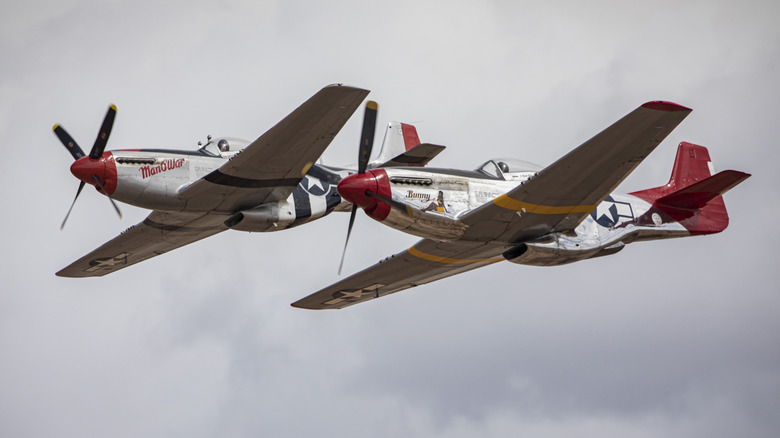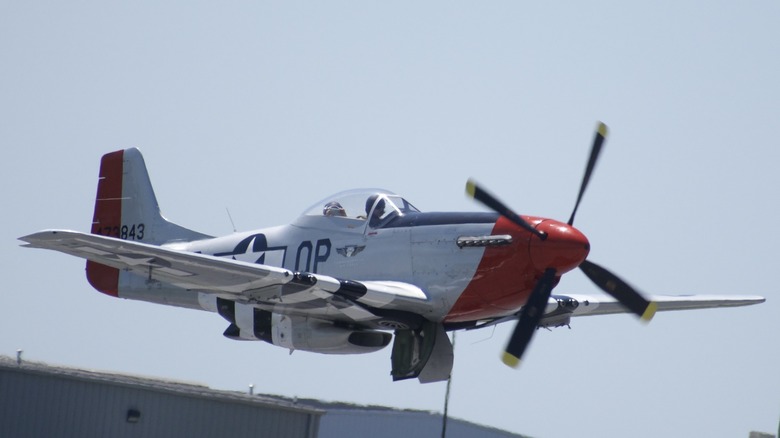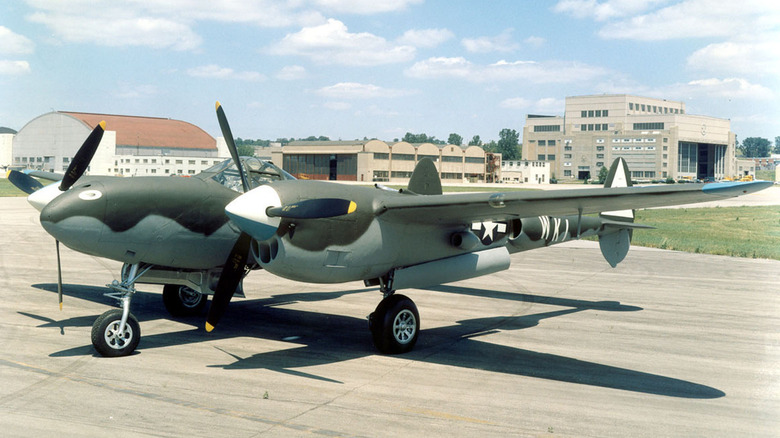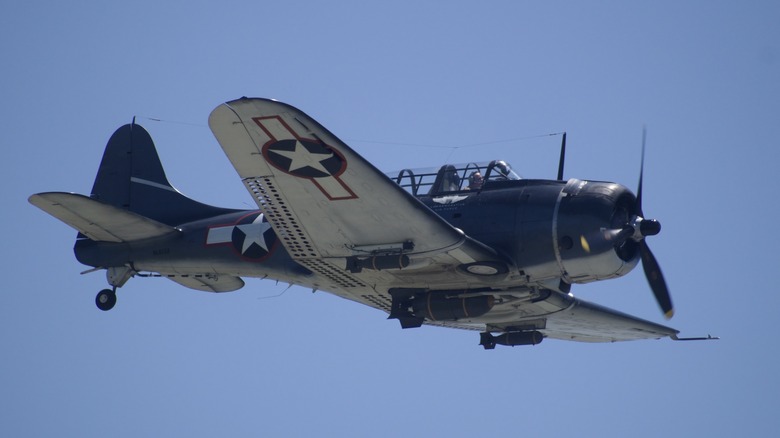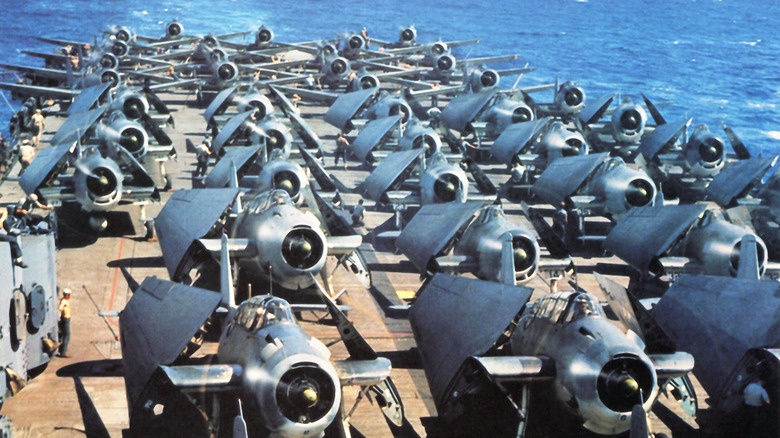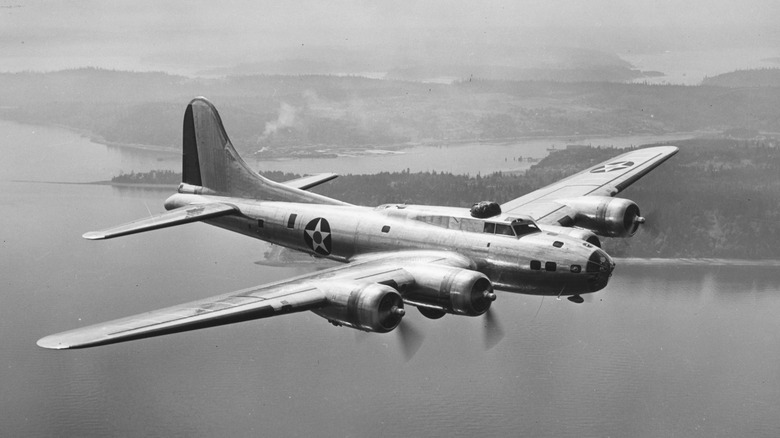5 Of The Best American Planes Used In World War II
A large portion of World War II was fought in the air, and, as such, there was incredibly rapid development of aviation technology. The Allies and Axis Powers were not only battling each other on the beaches, landing grounds, fields, streets, but were also trying to out-engineer each other when it came to the best aircraft. The Nazi's Third Reich may have developed the first jet engine and made the world's fastest aircraft at the time with the Me 262, but it was too little, too late and fortunately failed to make any real impact in the eventual outcome of the war.
The U.S. military deployed dozens of different aircraft in the fight against the Axis powers. Some, like the Brewster Buffalo, fell short of the mark. But many performed spectacularly in combat and are credited with hundreds of individual air-to-air and air-to-ground victories. The Americans' air power has been credited with turning the tide of the war on multiple occasions in both the Pacific and European Theaters.
North American P-51 Mustang
Volumes of books have been written about the North American P-51 Mustang as it's one of the most recognized aircraft to ever fly and is quite possibly one of the most important vehicles to ever exist. Its individual combat record is unheard of, even in today's world of stealth fighter jets and it was adored by the pilots who flew it and feared by any enemy pilot unfortunate enough to hear the cacophony of its six machine guns paired with its Rolls-Royce/Packard "Merlin" powerplant. No aircraft will ever be perfect, but the P-51 comes fairly close. It's worth noting that the U.S. Senate regarded the Mustang as "the most aerodynamically perfect pursuit plane in existence."
The Mustang's wickedly fast top speed of 425 miles per hour, withering amount of firepower, and good old fashioned skill of the pilots who flew them made the P-51 the undisputed king of the skies over Europe. It just couldn't be outdone anywhere it flew. The Me 262 jet fighter was more technologically advanced and significantly faster than the Mustang, but that didn't amount to much as pilots like Chuck Yeager (the same man who would break the sound barrier) shot down an Me 262 while he was behind the flight stick of a Mustang.
Lockheed P-38 Lightning
The Lockheed P-38 Lightning didn't share the hotrod looks of the Mustang, but that didn't mean it wasn't deadly. In fact, its twin-tail appearance earned it the nickname of the "Forked-Tail Devil." It had more air-to-air victories than most other planes in the sky and was formidable in just about any role. It could take down Mitsubishi A6M Zeros in the Pacific, support troops on the ground in Europe, or take pictures over enemy territory. Whatever the Allied command wanted the P-38 to do, it would do astonishingly well, with a trail of disabled Axis aircraft in its wake.
Medal of Honor recipient Major Richard Bong used a Lightning as his plane of choice to score 40 enemy aircraft kills, the most in U.S. military history. The nose of the P-38 was equipped with four .50 caliber machine guns and an extra spicy 20mm cannon that could easily double as anti-armor gun if the need arose. The current Lockheed Martin F-35 Lightning II, a highly advanced do-it-all fighter plane was named after the P-38 Lightning. The F-35 is the most advanced plane to bring the fight to the air, sea, or land, but the P-38 might be the best one to ever do it.
SBD Dauntless
One can scarcely mention aircraft carrier operations in the Pacific Theater without heaping adulation on the SBD Dauntless. "SBD" actually stands for "Scout Bomber Douglas" after the manufacturer, Douglas Aircraft. But Naval aviators gave it the more apt nickname of "Slow But Deadly." As opposed to many of the star planes in the Allies' hanger, the SBD was not fast and topped out at about 250 miles per hour flying level. But air-to-air combat was not the role of the Dauntless. It was strictly a dive-bomber and became the bane of a total of 18 enemy warships in the Pacific Theater. It could dive nearly straight down (between 70 and 80 degrees) drop a bomb directly onto the deck of an enemy aircraft carrier or battleship, and get out of harm's way before the Japanese Imperial Navy even knew what happened.
The Dauntless was slowly phased out by the end of the war. But the damage dealt by SBDs crippled the Imperial Japanese Navy during the Battle of Midway. Dive-bombers were credited with sinking a total of four aircraft carriers, the Akagi, the Kaga, the Hiryu, and the Soryu. The Imperial Navy never recovered before the war was over.
Grumman F6F Hellcat
To address the nomenclature elephant in the room, the Dodge Challenger SRT Hellcat is in fact named after the Grumman F6F Hellcat.
But the F6F is much more than the namesake for a goofy muscle car. It was one of the most dominant planes in the Pacific Theater and Allied forces flying the plane recorded a 19 to 1 kill ratio. This metric alone would qualify the Hellcat as one of the best fighter aircraft to ever exist. Like many other planes from the era, it served a variety of roles. The underwing pylons could be fitted with rockets and bombs. Until the invention of radar, flying in the dark of night was extremely dangerous, Hellcats became one of the earliest fighter planes equipped with radar to allow for more effective nighttime operations.
The Hellcat was most at home escorting aircraft carrier-borne bombers. In this role, the bombers could drop their ordnance on Imperial Japanese warships without the fear of harassment by Zero fighter planes. Under the Hellcats watch, only 42 bombers were shot down by Imperial aircraft during the last two years of the war.
Boeing B-17 Flying Fortress
The P-51 Mustang is without a doubt, one of the most famous aircraft of the war, but the B-17 Flying Fortress is a close second. It first saw combat with the United States in 1942, but was actually first fielded in 1941 by the British Royal Air Force. The B-17s wreaked havoc on Nazi Germany's factories, airfields, and a litany of other strategic targets, and they've been credited as a major reason why the Allies won the war. Factories made over 12,000 B-17s, allowing Allied forces to completely overwhelm Axis forces on the ground.
The B-17 worked best when it was escorted by planes like the P-51 which could dispatch any fighter planes ambitious enough to interrupt a bombing sortie. But that doesn't mean the bomber was defenseless. The "Flying Fortress" name wasn't just for fun. It was covered in nine total machineguns, allowing the plane to hold its own at least for a short time if the P-51s were occupied giving the Luftwaffe (Nazi Germany's air force) a run for its money.
B-17s were also known for being able to take a massive amount of punishment before tapping out of the fight. It's been reported by Boeing that some B-17s landed with as many as two out of its four engines entirely inoperable and covered in holes made by anti-air guns.
